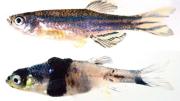Leonard Zon has captured the moment when a single cell first becomes cancerous—and he thinks that means an answer to cancer’s origins may be within reach. “We’re close,” he says. If scientists can pin down a cancer’s precise causes, they may be able to develop treatments to stop the disease even before it begins.
Zon, a professor of stem cell and regenerative biology in the Faculty of Arts and Sciences and Grousbeck professor of pediatrics at Harvard Medical School, runs perhaps the world’s most populous aquarium. His laboratory is filled with tanks of transparent zebrafish (300,000 of them), which he uses to study skin cancer. Tagged with fluorescent proteins, some fish glow red, others green, enabling him to see what is happening inside when a melanoma starts to form. These specially bred experimental fish have also been loaded with human-cancer-causing oncogenes. According to prevailing theory, they should all develop countless melanoma tumors.
But they don’t. When Zon first introduced the human skin-cancer gene into the fish several years ago, they merely developed moles—dense concentrations of skin cells (melanocytes) that may become cancerous, but are harmless most of the time. He then took an additional step, turning off the tumor-suppressing genes in the fish (“silencing” the genes, in the parlance of molecular biology), thinking that would certainly lead to massive numbers of melanomas.
But after several months, each fish developed only two or three tumors. “We were shocked that there wasn’t more cancer developing,” says Zon. “It had to be something else that was causing the cancer to grow” in those few instances. He suspected that the culprit was not a mutation, because sequencing 50 tumors failed to turn up a single mutation common to all or even some of them.
So what caused those tumors to grow? “Every cell in your body has the same DNA,” Zon explains. “What makes a cell in an eyeball different from a skin cell is which genes are turned on or off”—a process known as epigenetics. He quickly identified a gene that is normally active only in zebrafish embryos, but which his prior analysis of zebrafish tumors indicated was reactivated in the cancerous tumors of adult fish. He and his team tagged the gene with a green fluorescent protein so that the moment it turned on, any cell expressing it would literally light up. That made it possible to capture the cancer’s moment of inception and, critically, to identify any additional genes that “turned on” at the same time.

Researchers tagged a gene known to be active in cancer tumors so that it would fluoresce when activated, revealing the precise moment when a cancer begins.
Images courtesy of Charles Kaufman
The researchers found that a particular set of genes, when activated simultaneously, could reprogram a skin cell, shifting it back to a stem-cell-like state in which the cancer starts to grow. Scientists have long thought there might be a link between stem cells and cancer, because some cancer cells appear to possess the same capacities that characterize stem cells, which can divide indefinitely and differentiate through generations to become a variety of different kinds of cell. But they didn’t know whether cancer is caused by stem cells.
Stem-cell researchers figured out how to turn adult cells into stem-cell-like cells in 2006 (when Shinya Yamanaka created the first induced pluripotent stem cells). But cancer, it seems, has been doing this for a long time. “The initiating event in cancer,” Zon has found, is very much like the creation of those induced stem cells, involving “a reprogramming that brings the cell back to its roots by activating a set of key epigenetic regulators that work on DNA to activate and maintain” the cell in its altered, stem-cell-like state.
Zon’s lab is already working to identify the environmental factors that turn these reprogramming mechanisms on and off. “We think there are signals from outside the cell that actually direct the process to happen,” he continues, “teaching the inside of the cell how to reach a different state. At that point a tumor starts to grow.” The signals would need to be strong, he believes, because the strength of any signal that reaches a particular cell declines rapidly along what is known as a morphogenic gradient as it moves from one cell to the next. Furthermore, four signals need to converge on a single cell at exactly the same time to convert it to the cancerous state. That’s why cancer formation, he says, is, fortunately, an extremely rare event.
He believes his findings will be generalizable to other cancers. The cells of a cigar-smoker’s mouth, he points out, are bathed in carcinogens that cause mutations in DNA, predisposing the smoker to cancer in the same way that Zon’s zebrafish are predisposed to cancer because they carry human oncogenes. But that isn’t sufficient to cause a tumor to form. Zon speculates that the additional triggering event might be persistent inflammation or irritation, which many studies have linked to cancer. Maybe the tobacco juice, or the hot smoke drying mucous membranes, or simply the presence of a cigar hanging from the mouth, triggers inflammatory biochemical pathways in the body that in turn cause the formation of that first cancerous cell.
Now Zon is testing drugs, hoping to find one that turns on the gene tagged with the green fluorescent protein. That might provide a clue as to which signaling pathways—perhaps those involved in inflammation and stress—are most useful to study further. And if he finds a drug that turns the tagged gene off, it might form the basis for an anti-cancer therapy—a cream, for example, that could be rubbed on a mole to prevent cancer entirely, stopping the disease before it begins.









